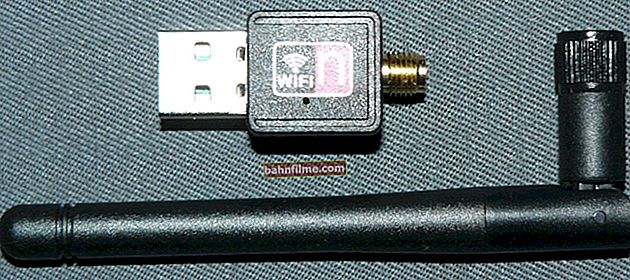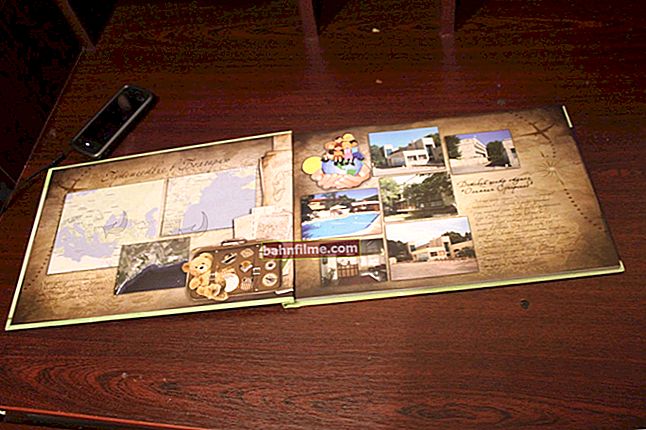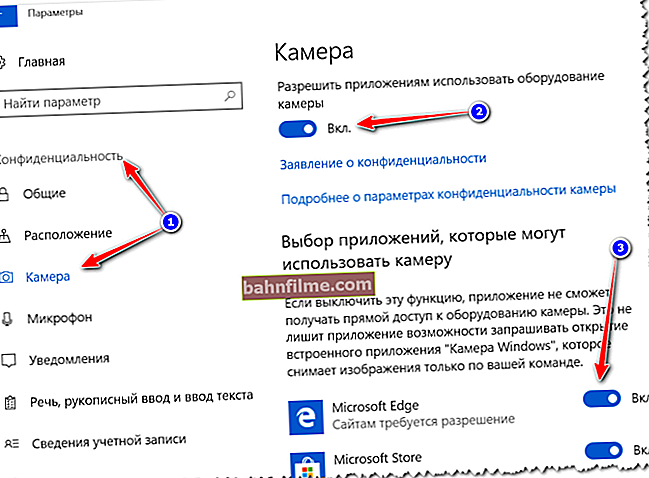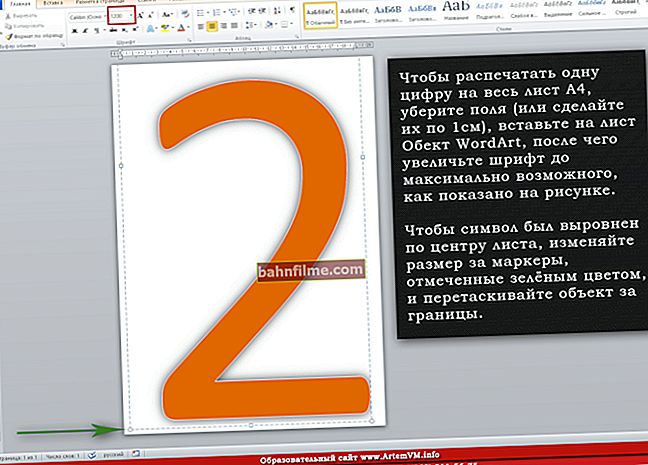 All the best!
All the best!
One of the most popular programs for working with documents, for the sake of which people have bought, are buying and will buy computers, is, of course, Microsoft Word! ☝
The program is already more than 2 decades old, but it has not lost its relevance, and now it is already considered almost a basic program on a PC - without it, and not there, and not here ...
Many actions in Word are simple and intuitive. But some of them are not so obvious, and I get asked questions about them quite often. So, in fact, a similar article was born ...
The purpose of this article is not to teach how to work in Word, not to show everything that can be done in it, but to answer the most popular questions that arise from any unprepared user who begins to do, for example, a report, an abstract, and any other document.
👉 Tip!
Many people are in no hurry to update Word - meanwhile, in the new version, as a rule, most actions are done much faster than in the previous one (there are many new and convenient tools that make everyday work easier).
Bugs and shortcomings have also been fixed. Moreover, in the new version you will be able to open documents with more progressive markup, while in the old one - something may go away and you will have to "finish" it. In general, my message is - try to work in the new version of Word ...
Note: all screenshots and descriptions of the lessons below are based on Word 2016 (2019) as the newest to date. If you have Word 2014, 2010, 2007 - almost all actions will be performed in the same way. Word 2003 and Word XP are a completely different hypostasis, you are unlikely to find hints on them here ...
*
Solving common problems in Word
Sorted in the order of their questions asked (at my discretion 👌)
How to number pages (except first / second)
In general, inserting pages by itself is not difficult. Usually, problems are created when you need to number from a certain page, for example, from the 2nd, 3rd, etc. Let's try to solve them ...
To add pagination to Word, you need to:
- go to section "Insert" ;
- choose "Page number" ;
- choose page number format: Top, Bottom, Center, Left / Right. Here, in general, I do not give recommendations - choose the option you want;
- actually, after the selected option - all your pages will be numbered.

Insert page number
How to number pages from 2, 3, etc. / How to make numbering in Roman numerals
First, you need to double-click the left mouse button on the page number: at the top of the window, you should see a link: "Working with headers and footers" ... Opening it, open "Page Norms / Page Numbers Format" ... On the screenshot below - see arrows 1, 2, 3, 4.

Change numbering
Next, a window will open in which you can specify from which page to make the numbering, as well as the numbering format: for example, you can put Roman numerals or letters (usually rarely used).

Format of page numbers
How to remove numbering from the first page
To remove the page number on the first sheet, you must:
- double-click on the page number with the left mouse button;
- then open the tab "Working with headers and footers" (it should appear after your clicks);
- then open the tab "Parameters" ;
- tick "Special header and footer for the first page" (see screenshot below, arrows 1, 2, 3, 4).

Special header for the first page
How to remove numbering from the 2nd, 3rd sheet (etc.)
This method is suitable for numbering from any page, and for skipping any number of sheets. In general, first decide which page you want to insert the numbers from.
1) Suppose if you want to insert numbers from the third page, then go to the second and place the cursor after the last character on it (arrow-1 on the screenshot below). Then open the section Layout, Breaks, Next Page (see screenshot below).

Page break
2) Next through the menu "Insert" insert pagination. She, by default, will number all pages without exception. Let it be so for now.
3) Then click 2 times with the left mouse button on the number of the third page, open the section "Working with headers and footers" (will appear at the top), and uncheck the link with the previous section (see the screenshot below).

Deleting a Link to a Previous Section
4) Now you can safely go to the second page, select the header and footer and delete it (the Delete button). Now you will have numbering from the third sheet, and the first two will be blank. In principle, everything!

Deleting in the first section of the numbering
*
How to place a degree
The degree is usually understood as superscript text. Quite often it is needed in various formulas, tolerances, etc.
Let's say you want to write the number 35 to the power of 2. Then you need to write the number 352, then select the number 2. Then open the "Home" tab and select the icon with X2-  ... The degree will be given, the task will be completed!
... The degree will be given, the task will be completed!

Degree setting
More opportunities can be obtained if you select the desired text (the same "2"), and press the combination of buttons Ctrl + Dand then you can specify "Superscript" (degree), "Subscript", strikethrough text, etc.

Ctrl + D
*
How to write a formula
By the way, since we are talking about the degree, I think it is right to say a few words about formulas. It is much more efficient and more correct to set formulas not in text (as many do), but through a special formula editor: they look better, and nothing will go anywhere with your further editing of the text.
To insert a formula, you need:
- open section "Insert" ;
- then click on "Symbols" and choose "The equation" (as in the screenshot below).

Inserting a formula
After that, press the left mouse button on "a place for the equation" , open "Working with an equation" , and write the formula.
In general, the writing process itself is easy: just choose that you want to add fractions, sines, cosines and add numerical values.

Choosing a formula style
My formula is written!

Formula ready
*
How to make a line
By this term, different users understand everything in different ways (I apologize for the tautology). However, here are several ways to draw a line in a document.
1 way - dash
Just press the dash (minus) button several times - and a dotted line will appear in Word. If you hold down the button Shift + dash - you will see an underscore, the same straight line (see screenshot below).

Method 2 - underline text
To do this, just select the desired text, then open the "Home" tab, and select the icon "h" .

Method 3 - across borders
Open the section "the main" , then click on the border icon - and you can select the desired line: lower border, upper, left, right, etc.

Method 4 - inserting an arbitrary line
And, the last, probably the most universal, is the insertion of an arbitrary straight line, which can be drawn in any way!
To do this, open the section "Insert" , then press the button "Shapes" and select the tool "Line" ... Next, draw a free line on the page.

*
How to create a bibliography
Most novice users make a bibliography by hand. While in Word there is a special tool that seriously makes life easier and speeds up the process of working with a document.
Let's try to create an automatically (and convenient) bibliography.
For this:
- open the section "Links" ;
- then click on "Bibliography" ;
- insert "Bibliography" (see screenshot below).

Insert bibliography
Your list of references will be empty for now, so we have not made any references to it.
To add a link (i.e. some source to the bibliography), you need:
- put the cursor in the place where the link to the bibliography will be;
- open section "links" ;
- to push "Insert link" ;
- then choose "Add new source" ... Then you will be asked to indicate the author of the book, source, website address, etc. In general, fill in as required.

add new source
After the links have been placed, simply go to the bibliography and click on it "Updating references and bibliography" - all your links will be automatically placed! In general, a very convenient and fast tool, I recommend it!

Update bibliography
*
How to make footnotes
Footnote - this is a special. a tool that allows, for example, to decipher complex terms, to clarify a paragraph.
As a rule, a small number-digit will be shown at the end of a sentence / paragraph, and a transcript is given at the bottom of the page.
In general, such footnotes make it easier to read and understand the page, I recommend that you always put them when there is any doubt about whether they will understand you.
To insert a footnote:
- place the cursor where the footnote number will be;
- open the section "Links" ;
- then press the button "Insert footnote" .

Insert a footnote
Actually, you just have to write the text of the explanation at the bottom of the page. The screenshot below shows what a typical footnote looks like.

Footnote
*
How to frame a page
The page frame will help you to more beautifully and clearly design your document (besides, sometimes, there are special requirements when it is simply necessary).
To insert a frame: open the section "Design" and then press the button "Page Borders" .

Page borders
Next you need:
- first select the type of frame. In principle, for most tasks, the default frames in Word are enough (see arrow-1 in the screenshot below);
- then indicate the type of frame: for example, solid or dotted;
- then specify the color, line width, pattern;
- last - set whether to apply a frame to the entire document or to a separate section of it (if you need a frame for only one page / section - use the "Page Break" tool, by analogy with setting pagination, see item 1 in this article);
- click OK - and the frame will be ready!

Border setting
An example of a finished frame is shown in the screenshot below.

The frame is ready
*
How to make a table of contents
Table of contents - it is necessary in almost every large document so that you can quickly look through the work plan and find the desired page.
From my own experience, I can say that most users do it manually, and then add pages, they suffer that if the page has changed, the entire table of contents needs to be changed and edited. While in Word there is automatic table of contents, which unties the hands.
And so how to insert a table of contents:
- open the section "Links" ;
- then click on "table of contents / automatic table of contents" ... I recommend working with the automatic one. it's easier and faster.

Insert a table of contents
Next, go according to your text and place headlines ... To do this, select your title - and in the section "The main" choose a tool "Heading 1" (see screenshot below).

Heading 1
It is recommended to use subheadings in the video "Heading 2" (by the way, you can also use "Heading 3" ).

Heading 2
When all the headings in the document are arranged - just click on the table of contents "Refresh table" - all pages will be added automatically!
Thus, you can edit the entire document multiple times, change the headings / subheadings, and at the end, press again "Refresh table" - and your pages are all relevant again!

It was - it was
Note : by holding down the Ctrl key and hovering the mouse over the desired subtitle in the page, you can automatically go directly to the desired page of the document.
This is another advantage of creating a table of contents this way (there will be quick links to jump to any part of the document).
*
How to make a landscape sheet (a separate sheet in a document)
Quite often, a sheet in Word needs to be placed not vertically (portrait page), but vertically (landscape orientation).
To make a landscape sheet orientation: open the section "Layout" then click on "Orientation / landscape" (see screenshot below).

Album sheet
In general, your sheet will turn and become horizontally positioned.
Quite often it is required not to make all sheets in a document landscape, but only a part of them. To do this, you must use a special. tool Page Break (under Layout).

Page break
After the page break is set, you can rotate the next page and make it landscape, while the previous page remains in portrait orientation (see screenshot below).

Book and album sheets in a document
*
How to make a paragraph (red line)
Method number 1
The easiest and fastest way to indent (red line) is to press the key TAB .
Method number 2
It is more efficient to use another method - using rulers ... This tool will allow you to adjust the exact size of the indentation. (note: when drawing up different documents - the requirements may be different).
To enable the ruler tool - go to the section "View" .

Ruler
Then place the cursor in front of the first character of the line you want to move (i.e. where you need a red line). Then, on the ruler, drag the top slider - the text will automatically move.

Red line
And one more thing, if you want to adjust the exact indentation in centimeters: select a paragraph, then right-click - in the pop-up menu, select "Paragraph..." .
Next, specify the exact indent in cm that you need. You can also set the line spacing. In general, everything is customizable depending on your job requirements.

Setting the indentation
*
How to write text vertically
You can write vertically text in Word in several ways. I will give a couple of them, which I myself use quite often.
Method number 1 - inserting a block of text
First, place the cursor where you want to insert the text block on the page. Next, open the section "Insert" , press "Test field / simple label" .

Then you can easily use the rotation icon to rotate the text field to any position: even vertically, even horizontally, even at any of the angles ...

Method number 2 - using the table
First, we insert the table - it can consist of one column and one row.
Note: to insert a table, open the "Insert" section, then select "Table", and specify the number of columns and rows (I recommend 1 each - if you just need to write text vertically).

Next, right-click on any place in the table (I recommend that you already write a couple of words there for clarity), and select from the pop-up menu "Text direction" .
Then choose text direction and click OK. The text will become vertical in the cell - the problem is solved (see screenshot below).

*
How to write Roman numerals
In general, Roman numerals are not needed very often. But if you are a historian, or do work on history, then you may well need it. I'll consider a couple of ways ...
Method number 1
I won't be original, just use Latin characters on the keyboard: I, V, X.
Method number 2
It is much more interesting if you need to get a specific figure - do not calculate it manually ?!
To do this, press the combination of buttons Ctrl + F9 then two parentheses appear {} .
Between these brackets you need to write something like {= 2017 \ * Roman} (Where 2017 Is the number you want in the Roman account).
After you have written the formula, press the F9 button - and the problem will be solved!

*
How to build a diagram
In my opinion, it is much more convenient to build a chart in Excel, and then insert it into Word (although many immediately do it in Word).
👉 To help!

I recommend checking out my article on creating charts in Excel.
And so, in order to insert a diagram in Word, you need:
- put the mouse cursor in the right place;
- open section "Insert";
- click the insert chart button -
 .
.

Insert a chart
Next, you need to select the type of chart: pie, histogram, linear, dot, stock, surface, radar, etc.

Choosing a chart
After you select the type of chart, a small Excel window will open up asking you to enter numbers. Enter the necessary numbers, depending on them your diagram will change.In general, a convenient and visual representation of any dependencies, calculations, indicators, etc.

Filling in the diagram with numbers for visual representation
*
To be continued ...
Good luck!
👋
First publication: 19.02.2017
Correction: 01/05/2020
 .
.








